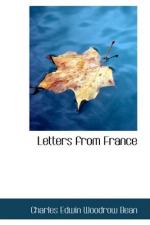It was after dark on a winter’s night that he and his men—about sixteen of them—crept out up a slimy trench deep to the knees in sloppy mud; peered at the enemy’s wire against the skyline; half crawled, half slid through a gap in it, and disappeared, Tim leading. A white flash—a shower of bombs—red and orange flares breaking like Roman candles in the sky—the chatter of a machine-gun—the enemy’s barrage presently shrieking down the vault of heaven. A dozen wounded men came back before dawn. And Tim—Tim lay with his face to the stars, dreaming for ever and ever of red plains and travelling sheep, on the edge of Tamar the Hammerhead’s Grass Bank.
Slime Trench—Grass Bank—Gibbs’ Corner—you will read of them all in their chapter in the War’s History. They were in every map for a month—the newspapers made headings of them—they were household words in London suburbs and Melbourne teashops. A month later the flood of battle swept past them all in a great general attack without so much as pausing to look. Two months—and a string of lorries pushed up a newly made road until a policeman held them up, just as he would in London, to let some cross stream of traffic through. One of the crossing lorries bumped into a hole and impaled itself on a beam that had fallen off the lorry ahead. The two drivers of a lorry far behind climbed up a steep, shell-shattered neighbouring bank, and munched bread and bully beef while the afternoon grew to dusk and gun flashes showed like lightning on the angry low winter clouds ahead.
“What they want to get us stuck in this flaming mud-hole for?” said the driver to the second driver. “The Huns must have had a dug-out down there, Bill,” he added, pointing to certain splintered, buried timber at the foot of the bank.
Now there may be no such place as the Grass Bank; and there may have been no Hammerhead nor Tim Gibbs; and he did not come from Booligal. But the story is true to this extent—that it happens all the time upon this battlefield.
CHAPTER XXXI
IN THE MUD OF LE BARQUE
France, December 20th.
By the muddy, shell-pitted roadside of the sunken road in Le Barque, behind the German lines, were found three shapeless forms. The mud dripped from them as they lay, but they were the forms of men. And the German soldiers who saw them, and who buried them, took it that they were men who had not lost their lives from any shell wound; that they had not been killed by the fire of our machine-guns, or by stray bullets. They put down the death of those men to the mud and the mud alone. The sunken road at Le Barque had been mashed with shells and trampled to slime with traffic; some runner from battalion headquarters at night, slipping through the sleet, some couple of men straggling after the tail of an incoming platoon on a wild night when the English barrage suddenly startled them and caused them to miss the path by a few yards in the blackness, had stumbled unnoticed into a shell-hole. All their company officer knew was that they were missing—and no trace of them was found until three bodies were dragged from a shell crater, when men told stories of men missed there before.




